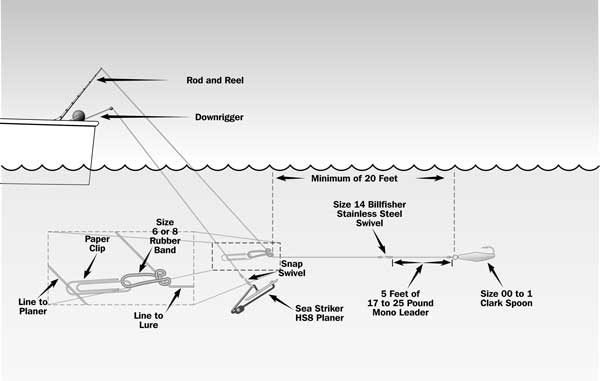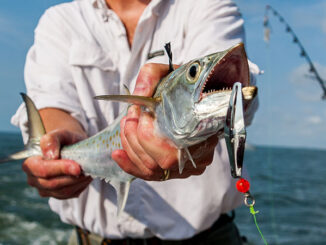
Spanish mackerel are a favorite fish of many anglers, and rightfully so. They arrive in late April and stick around through October — sometimes into November — and they usually will bite well.
Add to this that they are usually pretty close to the beach, they’re easy to get to and excellent table fare, and catching Spanish mackerel is a winner all the way around.
Spanish mackerel are fish that are used to introduce most inexperienced fishermen to trolling. Think about it; they are close by and usually feeding, so there is rarely a lapse in the action to allow short attention spans to wander.
The only possible negative in catching Spanish macks is the tackle required for the trolling planers and sinkers that are used to carry lures down to the strike zone is heavy enough that the small fish are often overpowered. Wouldn’t Spanish mackerel be even more fun if you could catch them on appropriately-sized tackle?
Well, you can, and it really isn’t difficult!
What if I told you there was a way to use your favorite trout tackle to troll for Spanish mackerel? With trout tackle, you can feel the fight in a barely- legal Spanish, and one that weighs several pounds will be able to make a couple of runs. I’m pretty sure if you give this method a try, you’ll find yourself using it often.
Several unusual pieces of equipment are required to do this. A bag of size 8 or 6 rubber bands is hardly considered regular fishing tackle, and a box of small paper clips is even more curious. However, these are the two main ingredients that allow this technique to work.
Size 8 rubber bands are the small ones, much like those used with dental braces. Size 6 rubber bands are a little smaller and lighter. Size 8 rubber bands will usually break at about four pounds of pressure and size 6 at about three pounds. Putting them in direct sunlight will weaken them. You can find size 8 rubber bands at most office-supply stores. Size 6 are usually by special order only, which is way I learned how to weaken the size 8s.
A larger planer is also needed, plus a way to deploy it. Planers come in sizes from No. 1 (smallest) to No. 32 (largest). Nos. 1 and 2 are the most popular for using in-line with a rod and reel. Often, a No. 3 is used on a hand line to get a little deeper. Some folks feel fine using up to a No. 5 on mid-weight tackle, but I would suggest using a planer rod-and-reel setup, a downrigger or a hand line from this point up. My favorite planer for this application is a Sea Striker high speed No. 8 (HS8).
While most downrigger manufacturers recommend against using planers on downriggers, I have found most will easily handle up to the medium sizes. If you choose to use a downrigger for this technique, I would recommend it is mounted to the boat by through-bolts, not screws. A major plus for using a downrigger is the ease of adjusting the depth of the planer.
If you have any concerns regarding using a downrigger to hold the planer, don’t do it! A suitable hand line can be made rather inexpensively, and it will work fine. The hand line is just a little more difficult to adjust the planer depth and handle when winding it in. The Sea Striker HS8 is available in a kit, complete with a hand line and a storage pouch.
Unlike using a downrigger ball at slow speeds, a planer relies on moving faster to get it to dive. The planer doesn’t dive straight down, but it pulls at a 15- to 45- degree angle, slightly behind the boat, based on planer size and trolling speed. This characteristic is what allows this technique to work.
I begin with my favorite trout rod and add a size 14 (70 pounds) Billfisher stainless-steel swivel — roughly half the size of most swivels — which allows it to be used close to the lure. Behind the swivel, I add five feet of low-visibility green monofilament in 17- to 25-pound test. My lure of choice is a No. 00 or 0 Clark Spoon in silver or gold, which is tied at the end of the low-vis mono.
To deploy this rig, attach the planer to the hand line or downrigger and set it to the desired depth. Sometimes, the correct depth is an educated guess, but if you are marking bait or fish on your fishfinder, set it just above their depth. A general rule for the 5-to 8-knot trolling speed for Spanish mackerel is the HS8 Planer dives one foot deep for every three to four feet of line that is out.
Once the planer is set, drop your Clark Spoon back to the distance you want it behind the planer. I recommend a minimum of 20 feet, and 50 feet is not too much — especially on a day the fish are skittish. Wrap the size 8 (or 6) rubber band around the fishing line and pull it back through itself so it cinches down on the mono. Now, slip the other end of the rubber band onto one of the paper clips and slip the other end of the paper clip around the line (hand line or downrigger line) going down to the planer.
Slowly let line off the reel, and the drag on the Clark Spoon will drag the lure and paper clip down the line to the planer until the paper clip stops at the snap swivel. Letting out more line after the paper clip stops will create a bag of line in the water and might pull the paper clip back up the line, so keep this fairly tight.
Now you are fishing using the line to the planer to support the planer and guide the Clark Spoon down to the desired depth. The rubber band acts as a small shock absorber but is light enough it will break when a fish strikes. Once the rubber band breaks, you fight the fish on the lighter tackle without the extra drag of a planer or trolling sinker.
After landing a fish, just drop the lure back again, attach another rubber band and paper clip, attach the other end of the paper clip to the line to the planer and let the lure drag the paper clip down the line to the planer. The line from the downrigger (or hand line) holds the planer and takes all the stress of trolling. When the rubber band breaks, you fight the fish on lighter, appropriate-size tackle.
This technique also works for larger lures and fish. In fact, the larger the lure, the better it works. Heavier rubber bands are needed for bigger lures and fish, and I switch from paper clips to snap swivels to clip the lure to the planer line.
Regardless of size, the basics of the technique remain the same. The planer is carried on the hand line or downrigger line and doesn’t put that constant stress on the line with the lure. This allows the tackle to match the fish, not the planer. When the fish hits, the rubber band snaps, the lure separates from the planer and fish is landed without also having to fight the planer. This can sure make Spanish mackerel fishing fun — for kids of all ages!





Be the first to comment